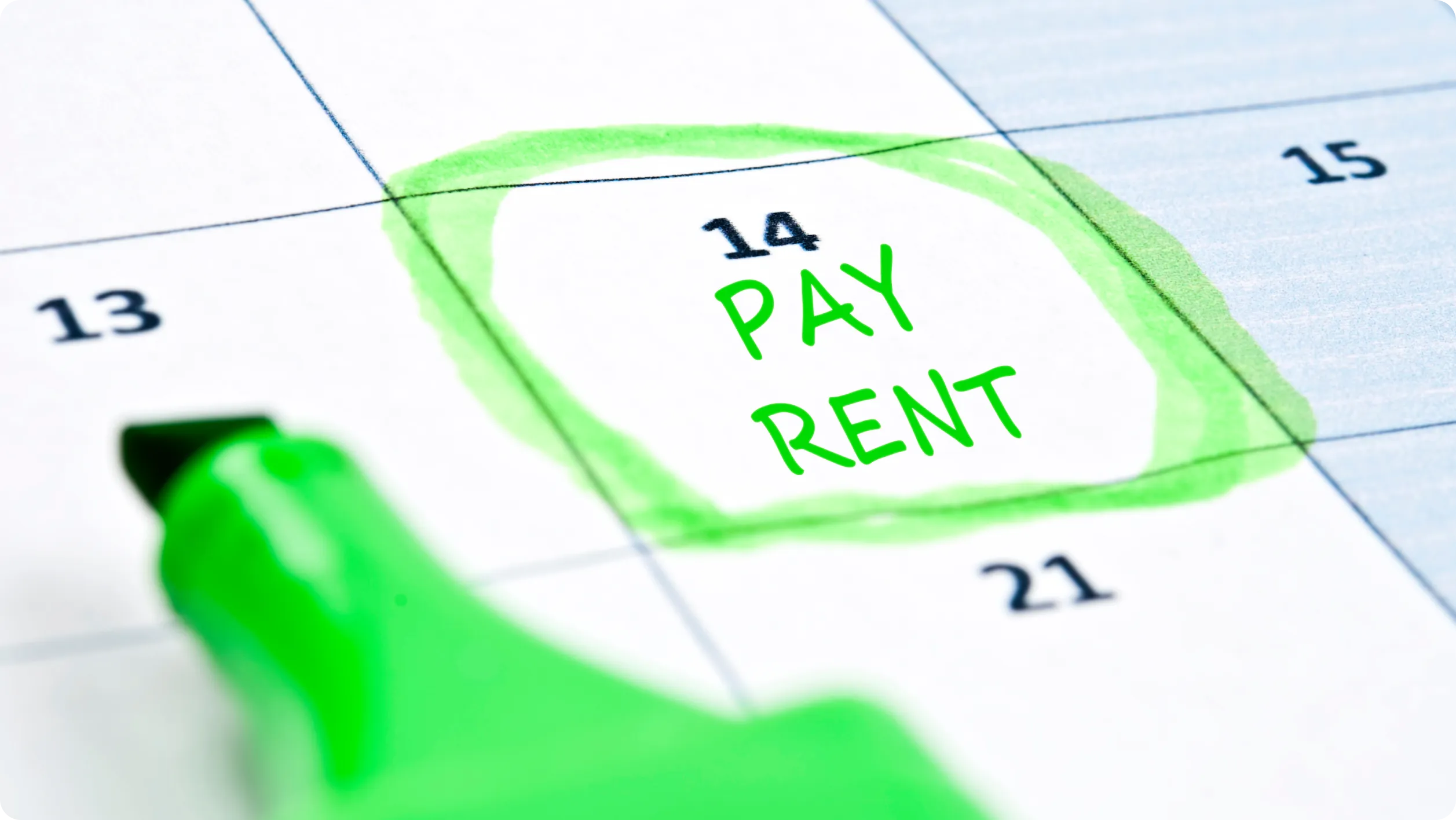What is prorated rent?
Prorated rent is a partial rent payment based on the number of days a tenant occupies a unit during a partial month. Instead of charging the full monthly amount, you calculate rent only for the days they’re living in the property. This is common during mid-month move-ins or move-outs and helps ensure fair billing. A prorate rent calculator move-out or prorated rent calculator, makes this process quick and accurate.
How the rent proration calculator works
Imagine you have a unit ready for a new tenant on the 15th of the month. Instead of charging them for the full month, you’ll prorate the rent based on their move-in date. Similarly, if a tenant gives proper notice and moves out on the 20th, you’ll calculate the rent owed only up to that date. Our prorated rent calculator simplifies this by asking for key pieces of information:
- Full monthly rent amount: The standard rent for a full month.
- Move-in or move-out date: The specific day the tenant starts or stops occupying the unit.
- Total days in the month: The actual number of days in the specific calendar month (e.g., 30 for June, 31 for July).
- Billing method (optional): Choose between the Calendar Days Method or the 30-Day Standard Method.
Once these details are entered, the calculator quickly provides the outputs:
- Total prorated rent owed: The final amount the tenant needs to pay for the partial month.
- Breakdown of daily rent rate: How much rent accrues per day.
- Number of days occupied: The count of days from the move date to the end/beginning of the month.
- Payment due date: This output might refer to the standard rent due date specified in the lease, or the calculator may note that the prorated amount is typically due on the move-in date or the first standard rent due date after move-in.
Using a calculator eliminates manual errors and saves valuable time for both landlords and tenants.
Why use a prorated rent calculator?
Accuracy and efficiency are paramount in property management. Using a dedicated prorated rent calculator offers significant benefits for both you and your tenants:
For landlords:
- Faster vacancy filling: A prorated rent calculator lets you rent a unit as soon as it’s ready, even mid-month, helping reduce vacancy loss.
- Improved tenant relationships: Using a rent proration calculator shows fairness and transparency, setting a positive tone from day one.
- Error reduction: A prorate calculator for rent automates the math, preventing costly mistakes and avoiding disputes.
- Time Saving: Whether it’s a move-in or a prorate rent calculator move out, you’ll get accurate amounts instantly, no manual work needed.
For tenants:
- Fair payment: Ensures they only pay for the exact number of days they occupy the property.
- Transparency: Provides a clear breakdown of how the prorated amount was determined.
Ultimately, a calculator is a tool that supports clear communication and proper financial management in rental properties. Especially when you need a fast, accurate answer for how to prorate rent for a month.
Calculating prorated rent for move-in dates
When a tenant moves in after the first day of the lease term, they owe prorated rent for the days remaining in that first partial month.
Steps:
- Determine the full monthly rent amount.
- Determine the exact move-in date.
- Determine the number of days in the month the tenant is moving into.
- Calculate the number of days the tenant will occupy the unit.
- Apply the chosen method (Calendar Days or 30-Day Standard).
Example (Calendar Days):
- Monthly rent: $1,800
- Move-in date: August 10th
- Days in August: 31
- Days occupied: 22
- Calculation: ($1,800 / 31) × 22 = $58.06 × 22 = $1,277.39
The tenant would owe $1,277.39 for the partial month of August, in addition to any security deposit, pet fees, or other initial move-in costs.
Calculating prorated rent for move-out dates
If a tenant moves out before the end of their lease term or at the end of their lease but mid-month, they typically owe prorated rent up to their move-out date. Note that prorating rent for a tenant moving out before the end of their lease term is often not legally required unless specified in the lease or local law, especially if they are breaking the lease. However, it is standard practice at the very end of a lease term if the move-out date isn’t the last day of the month.
Steps:
- Determine the full monthly rent amount.
- Determine the exact move-out date.
- Determine the number of days in the move-out month.
- Calculate the number of days occupied.
- Apply the chosen method (Calendar Days or 30-Day Standard).
Example (Calendar Days):
- Monthly rent: $1,800
- Move-out date: September 25th
- Days in September: 30
- Days occupied: 25
- Calculation: ($1,800 / 30) × 25 = $60.00 × 25 = $1,500.00
The tenant would owe $1,500.00 for the partial month of September.
Important considerations when prorating rent
Calculating the prorated amount is just one part of the process. Several other factors are
important to keep in mind:
- Lease agreement: Your lease should explicitly state how prorated rent is calculated and when it is due. This prevents misunderstandings and provides a clear reference point. It’s crucial to have this documented alongside other terms.
- State and local laws: Always check your local ordinances and state laws. Some jurisdictions have specific requirements for how rent must be prorated or if it is required at all, especially for move-outs.
- Leap years: If using the Calendar Days Method, remember that February has 29 days in a leap year, which will slightly affect the daily rate calculation for that month.
Rent due date vs. 1st of the month: While rent is often due on the 1st, a tenant’s move-in might be on a different date. The prorated calculation is based on the move-in/move-out date, not the standard rent due date. Ensure your lease clarifies when the prorated amount for the first month is due (e.g., on the move-in day, or grouped with the second month’s full rent).
The more value your amenities add, the more you can charge for rent. However, it’s important to avoid overcharging. Your rent price should be in line with properties that have similar amenities.
Streamline rent collection with Baselane
Calculating prorated rent is key when tenants move in or out mid-month. Using a prorate rent calculator move-out tool ensures accuracy, saves time, and keeps billing fair.
Once you’ve calculated the amount, the next step is to use a rent collection app. Instead of relying on checks or manual tracking, modern rent collection property management tools let you invoice for the exact amount, track payments, and even manage partial or unpaid rent. Many platforms support online payments, including paying rent with credit card options for tenants.
With Baselane, you can handle it all. Accurate calculations, automated invoicing, and streamlined rent collection, in one place.
Simplify rent proration and collection with Baselane’s all-in-one landlord platform. Sign up for free today.
FAQs
What is the formula to prorate rent?
The standard formula is: (Monthly Rent ÷ Total Days in Month) × Days Occupied. Some landlords use the 30-Day Method: (Monthly Rent ÷ 30) × Days Occupied. How prorated rent works depends on which method your lease or local laws support.
How do you prorate rent when moving out?
Use a prorated rent moving out calculator to determine the daily rate, then multiply by the number of days the tenant occupied the unit in their final month. This ensures accurate billing and avoids disputes.
Do landlords have to prorate rent moving out?
Whether landlords have to prorate rent when a tenant moves out is often determined by the lease agreement and local laws. While common practice when a lease ends mid-month, it's not always legally required if a tenant breaks a lease early.
How to prorate rent for a partial month?
Divide the full monthly rent by the total days in the month (or 30), then multiply by the number of days the unit is occupied. This is standard when offering a lease concession or adjusting for mid-month tenancy changes.
How to prorate last month's rent?
Prorating last month's rent uses the same calculation methods as any other prorated rent. If a tenant is moving out on the 20th of their final month, you calculate the rent for days 1 through 20. This applies whether it's the last month of a fixed term or a month-to-month lease ending mid-cycle.
How to prorate apartment rent?
Prorating apartment rent is no different than prorating rent for any other type of rental property. You use the full monthly rent amount for the apartment and apply one of the standard prorating formulas based on the move-in or move-out date.
How to prorate monthly rent?
Prorating monthly rent means calculating a portion of the standard monthly rent amount. This is done by finding the daily cost of rent and multiplying it by the number of days the tenant will occupy the property during the partial month.
Are landlords required to prorate rent?
Not always. Whether you must prorate rent depends on the lease terms and local regulations. It's common practice when leases end mid-month, but it may not be required if a tenant breaks a lease early.




